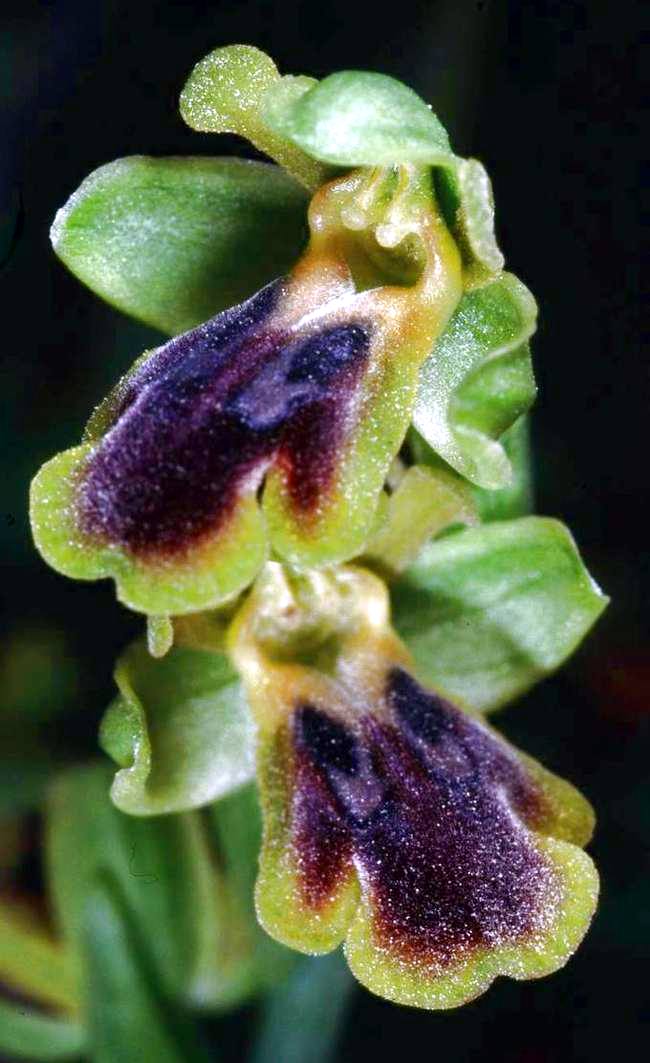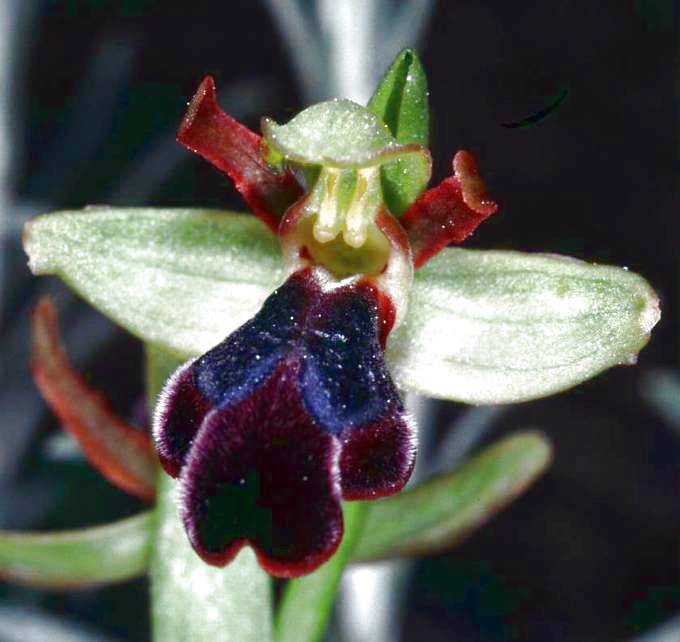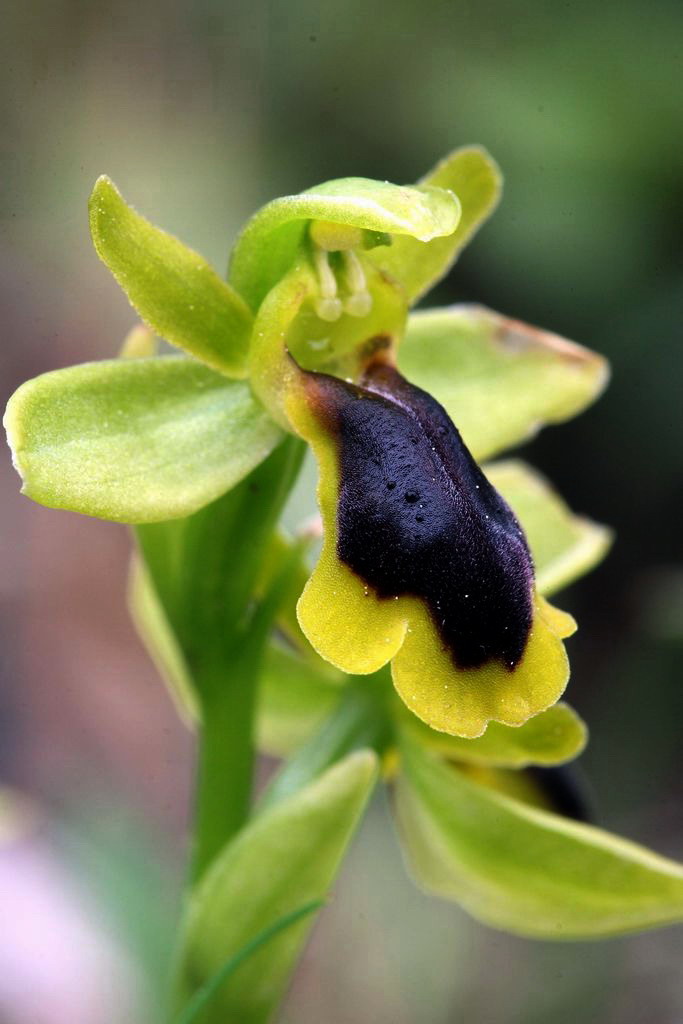 |
 |
 |
 |
 |
 |
| A5-1. A5-2. A5-3. |
O. blitopertha O. persephonae O. urteae |
This very strange Ophrys has the particularity of being pollinated by a beetle, Blitopertha lineolata, which, as far as known, is unique in the genus. This is an oriental plant, distributed from the Cyclads to Anatolia. It's a slender and small plant, growing in very sunny garrigues and other open places, contrary to the next species which favours more dark pine woods. The species is very variable as can be seen from slides 2 to 9, all flowering together at the same Rhodian site, the same day. Zissis Antonopoulos (Thessaloniki, Greece) discovered it on the island of Kos and has kindly given slides 10-11. He noted the presence of plants with large lips (length 12-13 mm, slide 10) and also plants with smaller ones (length 8-10 mm, slides 11). Etymologically, the archaic Greek verb περθω (pertho), used by Homere and Herodote, means "to destroy, to wipe out", and βλητο (blito) is the name of plants belonging to the genus Chenopodium, wild spinaches, probably refering to the nutritive plant of the pollinating insect. Cet étrange petit Ophrys a la particularité, apparemment unique dans le genre, d'être pollinisé par un coléoptère, Blitopertha lineolata. C'est une plante orientale répandue des Cyclades à l'Anatolie. C'est une espèce grêle, souvent petite, qui affectionne les milieux très ensoleillés, garrigues, bords des chemins,..., au contraire de l'espèce suivante qui préfère l'ombre des pinèdes. Elle est très variable comme en témoignent les dias 2 à 9, toutes faites le même jour, au même endroit, à Rhodes. Zissis Antonopoulos (Thessalonique, Grèce) l'a découverte à Kos où il a noté la présence de plantes aux grands labelles (longueur 12-13 mm, dia 10) et d'autres aux labelles nettement plus petits (longueur 8-10 mm, dia 11). Au point de vue étymologique, le verbe grec archaïque περθω (pertho), utilisé par Homère et Hérodote, signifie "détruire, anéantir", et βλητο (blito) désigne les plantes du genre Chenopodium, les épinards sauvages, en allusion sans doute à la plante nourricière du pollinisateur. Pollinator - Pollinisateur : Blitopertha lineolata Bibliography : Paulus,H.F. 1998.- Der Ophrys fusca s. str. - Komplex auf Kreta und anderer Ägäisinseln mit Beschreibung von O. blitopertha, O. creberrima, O. cinereophila, O. cressa, O. thriptiensis und O. creticola ssp. nov. (Orchidaceae). J. Eur. Orch. 30: 157-201. | ||
| O. blitopertha 1 Slide Pierre Delforge Rhode-St-Genèse, Belgium | Greece, Naxos | 25-04-1997 |
| O. blitopertha 2 | Greece, Rhodes Gennadi | 29-03-2005 |
| O. blitopertha 3 With very flat flowers |
Greece, Rhodes Gennadi | 29-03-2005 |
| O. blitopertha 4 A scape with three flowers |
Greece, Rhodes Gennadi | 29-03-2005 |
| O. blitopertha 5 | Greece, Rhodes Gennadi | 29-03-2005 |
| O. blitopertha 6 | Greece, Rhodes Gennadi | 29-03-2005 |
| O. blitopertha 7 With very convex lip |
Greece, Rhodes Gennadi | 29-03-2005 |
| O. blitopertha 8 With very convex lip |
Greece, Rhodes Gennadi | 29-03-2005 |
| O. blitopertha 9 With obscured yellow around the lip |
Greece, Rhodes Gennadi | 29-03-2005 |
| O. blitopertha 10 Lip length: 12-13 mm Slide Zissis Antonopoulos Greece, Thessaloniki | Greece, Kos 138 m | 16-04-2005 |
| O. blitopertha 11 Lip length: 8-10 mm Slide Zissis Antonopoulos Greece, Thessaloniki | Greece, Kos 138 m | 16-04-2005 |
| O. blitopertha 12 | Greece, Samos Kambos - Kallithea Ag. Kiriaki | 11-04-2006 |
| O. blitopertha 13 | Greece, Samos Kambos - Kallithea Ag. Kiriaki | 11-04-2006 |
| O. blitopertha 14 Slide Helmut Presser Neumarkt in der Oberpfaltz, Germany With pollinator Blitopertha lineolata |
Greece, Rhodes Kattavia | 28-03-2013 |
| O. blitopertha 15 Slide Helmut Presser Neumarkt in der Oberpfaltz, Germany With pollinator Blitopertha lineolata |
Greece, Rhodes Kattavia | 28-03-2013 |
This is the second species of the group. It was recently discovered on the island of Rhodes by Dr. Hannes F. Paulus (Vienna, Austria) and, for the time being, was not found anywhere else. The pollinator is still unknown. The plant has a different ecology that O. blitopertha, favouring the shadow of pine forests, and is said to be stronger growing, although this is perhaps not the case of every single one, small plants with one or two flowers being also present. As you will see, the species is quite variable, slides 1 to 6 belong to the same population, snapped on the same day. You will find more informations about it under OPHRYS NEWS n°5. Plant is named in honour of Persephone, goddess of the Underworld. Be cautious, you're coming near dangerous places! Il s'agit de la deuxième espèce du groupe. Elle vient d'être découverte à Rhodes par le Dr. Hannes F.Paulus, (Vienne, Autriche) et, jusqu'à présent, nulle part ailleurs. Son pollinisateur reste inconnu. L'écologie de la plante n'est pas la même que celle d'O. blitopertha. O. persephonae préfère en effet l'ombre des pinèdes. Il a la réputation d'être en moyenne une plante plus robuste, mais on trouve aussi des exemplaires plus grêles n'ayant qu'une ou deux fleurs. Comme vous le constaterez en regardant les dias 1 à 6, toutes faites au même endroit le même jour, l'espèce est très variable. Vous trouverez davantage d'informations la concernant dans OPHRYS NEWS n°5. La plante est dédiée à Perséphone, déesse des Enfers. Soyez prudents, vous approchez d'endroits dangereux! Bibliography: Kreutz,C.A.J. 2002.- The orchids of Rhodes and Karpathos. Seckel & Kreutz Publishers, Raalte & Landgraaf: 192-195. Paulus, H.F. 2001.- Daten zur Bestäubungsbiologie und Systematik der Gattung Ophrys in Rhodos (Griechenland) mit Beschreibung von Ophrys parvula, Ophrys persephonae, Ophrys lindia, Ophrys eptapigiensis spec. nov. aus der Ophrys fusca s. str. Gruppe und Ophrys cornutula spec. nov. aus der Ophrys oestrifera-Gruppe (Orchidaceae und Insecta, Apoidea). Ber. Arbeitskrs. Heim. Orch. 18(1): 38-86. | ||
| O. persephonae 1 With large yellow edge |
Greece, Rhodes Loutani valley Locus typicus | 28-03-2005 |
| O. persephonae 2 | Greece, Rhodes Loutani valley Locus typicus | 28-03-2005 |
| O. persephonae 3 Very convex lip, narrow yellow edge |
Greece, Rhodes Loutani valley Locus typicus | 28-03-2005 |
| O. persephonae 4 | Greece, Rhodes Loutani valley Locus typicus | 28-03-2005 |
| O. persephonae 5 Almost no yellow edge around the lip |
Greece, Rhodes Loutani valley Locus typicus | 28-03-2005 |
| O. persephonae 6 A scape with three flowers |
Greece, Rhodes Loutani valley Locus typicus | 28-03-2005 |
| O. persephonae 7 | Greece, Rhodes Apollona - Laerma | 07-03-2010 |
| O. persephonae 8 | Greece, Rhodes Apollona - Laerma | 07-03-2010 |
| O. persephonae 9 Side view | Greece, Rhodes Apollona - Laerma | 07-03-2010 |
| O. persephonae 10 | Greece, Rhodes Apollona - Laerma | 07-03-2010 |
Professor H. F. Paulus and Mrs. Paulus dicovered close to Manavgat - Serik in Anatolia two populations of an Ophrys very close to O. blitopertha but differing by smaller flowers and another pollinator. O. urteae is a plant 6 - 15 cm tall bearing 1 - 3 (- 6) flowers. The very flat and dark lip is 9 - 12 mm long (m = 10.5 mm) which is significantly smaller than the lip of O. blitopertha, the length of being 12 - 15 mm (m = 12.9 mm). Both species are pollinated by Coleoptera, Scarabaeidae, Rutelinae; O. blitopertha by Blitopertha lineolata and O. urteae by Blitopertha nigripennis. B. lineolata is distributed in south-east Europe, in Aegean Anatolia and on the eastern shores of the Black Sea. On the other hand, B. nigripennis inhabits Cyprus, southern Anatolia east of Antalya and some regions of the Middle-East. The two areas are close together in Antalya but don't overlap as far as known for the time being. The Antalya meridian seems to mark the limit between the two species, with O. blitopertha in the west and O. urteae in the east. Le Professeur H. F. Paulus et Madame Paulus ont découvert près de Manavgat - Serik, en Anatolie, deux populations d'un Ophrys très voisin d'O. blitopertha mais qui s'en distingue par des fleurs plus petites et un autre pollinisateur. O. urteae est une plante de 6 - 15 cm de haut qui porte de une à trois fleurs (rarement jusqu'à six). Le labelle très plat et foncé mesure 9 - 12 mm de long (m = 10,5 mm) alors que celui d'O. blitopertha mesure 12 - 15 mm de long (m = 12,9 mm). Les deux espèces sont pollinisées par des coléoptères de la famille des Scarabaeidae, sous- famille des Rutelinae. Chez O. blitopertha il s'agit de Blitopertha lineolata et chez O. urteae c'est B. nigripennis. Blitopertha lineolata est répandu dans le sud-est de l'Europe, en Anatolie Égéenne et à l'est de la Mer Noire. Par contre, B. nigripennis habite Chypre, le sud de l'Anatolie à l'est d'Antalya et certaines régions du Moyen-Orient. Les deux aires de répartition se rejoignent, mais n'entrent pas en contact, près d'Antalya. Le méridien d'Antalya semble ainsi marquer la limite entre les deux espèces avec O. blitopertha à l'ouest et O. urteae à l'est. Pollinator - Pollinisateur : Blitopertha nigripennis Bibliography : Paulus, H. F. 2009.- Bestäubungsbiologie einiger Ophrys-Arten der Süd-Türkei (Prov. Antalya) mit Beschreibung einer weiteren "Käfer-fusca" Ophrys urteae spec. nov. (Orchidaceae und Coleoptera, Scarabaeidae). Ber. Arbeitskrs. Heim. Orchid. 26(2): 6-24. | ||
| O. urteae 1 Slide Hans Dekker Hoogeveen, The Netherlands Habitus | Turkey, Antalya Oymapinar | 22-03-2006 |
| O. urteae 2 Slide Hans Dekker Hoogeveen, The Netherlands Two plants | Turkey, Antalya Oymapinar | 22-03-2006 |
| O. urteae 3 Slide Hans Dekker Hoogeveen, The Netherlands | Turkey, Antalya Oymapinar | 22-03-2006 |
| O. urteae 4 Slide Hans Dekker Hoogeveen, The Netherlands | Turkey, Antalya Oymapinar | 22-03-2006 |
| O. urteae 5 Slide Ferdinand Ellenbast Hergensweiler, Germany Habitus |
Turkey, Antalya Tasagil | 07-04-2009 |
| O. urteae 6 Slide Ferdinand Ellenbast Hergensweiler, Germany A scape |
Turkey, Antalya Tasagil | 07-04-2009 |
| O. urteae 7 Slide Ferdinand Ellenbast Hergensweiler, Germany |
Turkey, Antalya Tasagil | 07-04-2009 |
| O. urteae 8 Slide Ferdinand Ellenbast Hergensweiler, Germany |
Turkey, Antalya Tasagil | 07-04-2009 |
| O. urteae 9 Slide Ferdinand Ellenbast Hergensweiler, Germany |
Turkey, Antalya Tasagil | 07-04-2009 |
| O. urteae 10 Slide Ferdinand Ellenbast Hergensweiler, Germany Two flowers |
Turkey, Antalya Tasagil | 07-04-2009 |